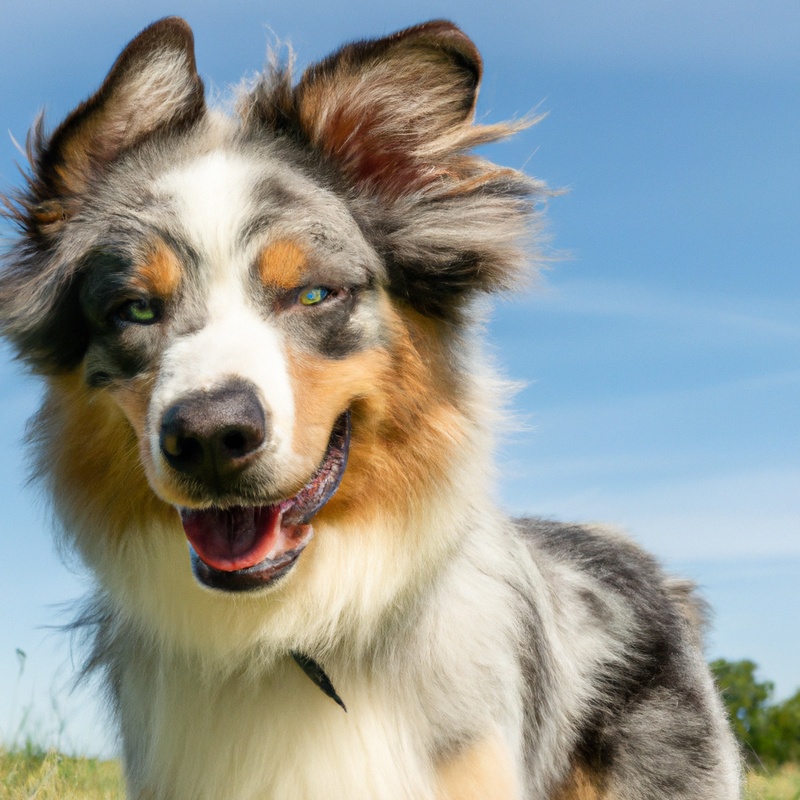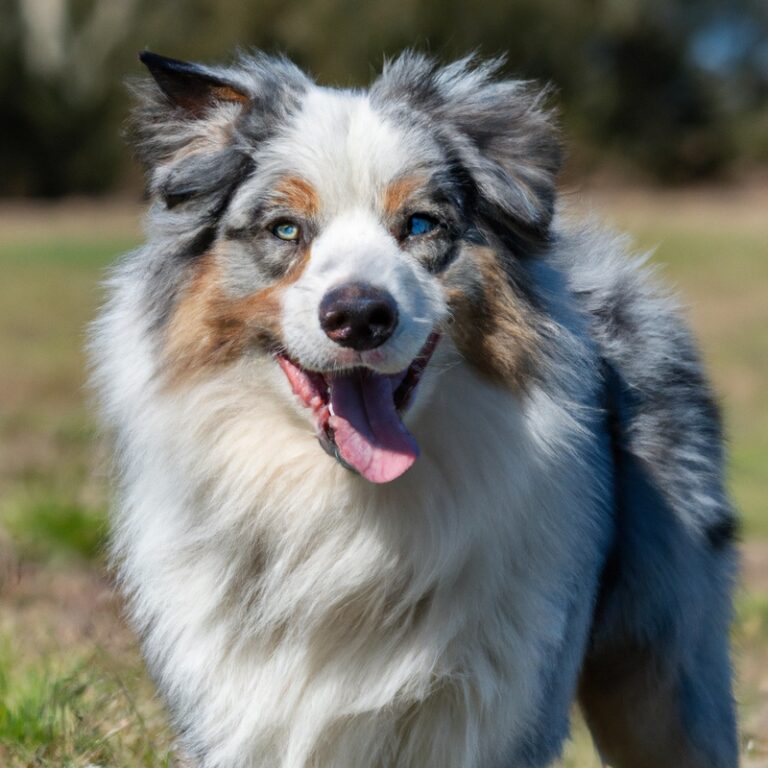How Do Australian Shepherds Behave When Introduced To New Small Mammals?
Key Takeaways:
- Australian Shepherds exhibit a cautious and observant behavior when introduced to new small mammals.
- They show a strong herding instinct towards small animals and may attempt to chase or gather them.
- It is important to introduce Australian Shepherds to small mammals in a controlled and supervised environment.
- Proper training and early socialization can help Australian Shepherds coexist peacefully with small mammals.
Have you ever wondered how Australian Shepherds react when they meet small mammals for the first time? As an expert in canine behavior, I’m here to shed some light on this fascinating topic.
These intelligent and active dogs possess certain natural instincts that can greatly influence their behavior.
From their herding instincts to their prey drive, understanding these traits is crucial for successful introductions. In this article, I’ll delve into the importance of proper socialization, gradual introductions, and the signs to watch out for when it comes to aggressive behavior.
Plus, I’ll provide tips on positive reinforcement training to encourage desirable behavior.
So, if you’re a proud owner of an Australian Shepherd or thinking of adopting one, keep reading to ensure a harmonious coexistence with small mammals.
| Behavior | Description |
| Curiosity | Australian Shepherds may exhibit a high level of curiosity towards small mammals, investigating and sniffing them cautiously. |
| Chasing Instinct | Due to their herding background, Australian Shepherds may display a strong chasing instinct towards small mammals, treating them as potential targets to herd or control. |
| Prey Drive | Some Australian Shepherds may have a high prey drive, causing them to view small mammals as prey animals and triggering a desire to chase, catch, or even harm them. |
| Adaptability | Australian Shepherds can adapt to the presence of small mammals over time, learning to coexist peacefully or ignoring them if properly introduced and supervised. |
| Training | With appropriate training and socialization, Australian Shepherds can be taught to have a controlled response to small mammals, obeying commands to leave them alone. |
Australian Shepherds’ Natural Instincts
Herding instinct and its impact on behavior
Australian Shepherds have a strong herding instinct which greatly impacts their behavior. This instinct is deeply ingrained in them and can manifest in various ways.
When introduced to small mammals, Australian Shepherds may exhibit behaviors such as chasing, nipping, or attempting to gather and control the movement of the animals.
It is important to understand that these behaviors are driven by their herding instincts rather than aggression. Herding instinct can have a significant impact on an Australian Shepherd’s behavior around small mammals.
They may become overly excited and may not understand that their behavior can be intimidating or overwhelming for the smaller animals.
This can lead to potential harm or stress for the small mammals. It is crucial to recognize and manage these instincts to create a safe and positive environment for all involved.
To address the impact of herding instinct on behavior, it is essential to provide proper training and socialization.
Through positive reinforcement training, Australian Shepherds can learn to control their impulses and respond to commands. Teaching them basic obedience commands such as “leave it” or “stay” can be helpful in redirecting their focus away from the small mammals.
Another effective approach is to gradually introduce Australian Shepherds to small mammals in controlled environments.
Start with short supervised interactions and observe their behavior closely. If the dog displays signs of excitement or fixation, redirect their attention to a different activity or command.
Repeat these controlled introductions over time, gradually increasing the duration and intensity of the interactions as the dog becomes more accustomed to the presence of small mammals.
It is important to approach herding instinct with patience and positive reinforcement. Punishment or harsh training methods can be counterproductive and may worsen the behavior.
Seek the guidance of a professional dog trainer or behaviorist who specializes in herding breeds if needed.
They can provide guidance on how to effectively manage herding instincts and tailor training techniques to your Australian Shepherd’s individual needs. With consistent training and proper socialization, Australian Shepherds can learn to coexist peacefully with small mammals.
Prey drive and its influence on interaction with small mammals
A dog’s prey drive refers to its natural instinct to chase and capture prey. Australian Shepherds have a moderate to high prey drive, which can influence their interactions with small mammals.
When introduced to small mammals, such as rabbits or squirrels, Australian Shepherds may exhibit intense focus, fixation, and a strong desire to chase.
It’s important to understand this instinctual behavior and take necessary precautions to ensure the safety of both the dog and the small mammals.
Introducing Australian Shepherds to Small Mammals
Importance of proper socialization
Proper socialization is essential for Australian Shepherds when introducing them to new small mammals. It helps them develop positive behaviors and reduces the likelihood of aggression or fear.
Socialization exposes them to different experiences, sights, sounds, and smells, allowing them to become comfortable and adaptable.
It also teaches them appropriate ways to interact with small mammals, promoting a harmonious coexistence. Regular and controlled introductions, along with supervised interactions, play a vital role in building a strong foundation for a positive relationship between Australian Shepherds and small mammals.
Gradual and controlled introductions
When introducing Australian Shepherds to small mammals, it’s important to take a gradual and controlled approach. This means slowly exposing your dog to the presence of small mammals in a controlled environment.
Start by allowing your dog to observe the small mammal from a distance, gradually decreasing the distance over time.
This allows your dog to acclimate and become comfortable with the presence of small mammals without feeling overwhelmed. It’s crucial to closely supervise these interactions and ensure the safety of both your dog and the small mammal.
Keep in mind that each dog is unique, so progress may vary.
Patience and consistency are key when introducing Australian Shepherds to small mammals.

Supervision during interactions
Supervision during interactions is crucial when introducing Australian Shepherds to small mammals. It’s important to closely monitor their behavior to ensure the safety of both the dog and the small mammal.
By supervising the interactions, I can intervene if necessary and prevent any aggressive or inappropriate behavior.
I keep a close eye on their body language and intervene if I notice any signs of aggression or fixation. This hands-on approach allows me to create a positive and controlled environment for the introduction, helping to build a peaceful and respectful relationship between the dog and the small mammals.

Signs of Aggressive Behavior
Growling, barking, or lunging
When introducing Australian Shepherds to new small mammals, it is important to be aware of signs of aggression in their behavior. Growling, barking, or lunging are common indicators that your dog may be feeling uneasy or threatened.
These behaviors can stem from their natural instincts, such as herding or prey drive.
Supervision is crucial during interactions and proper socialization is key. Positive reinforcement training can also help discourage aggressive behavior and reward calm behavior around small mammals.
If needed, seeking professional help from a dog trainer or behaviorist can provide guidance on behavioral modification techniques.

Raised hackles or stiff body language
Raised hackles or stiff body language in Australian Shepherds can be a sign of alertness, tension, or aggression when they are introduced to new small mammals. It’s important to pay attention to your dog’s body language in these situations.
Raised hackles, which are the hairs on their back standing on end, and a stiff body posture indicate that your Australian Shepherd is on high alert and may not be comfortable or relaxed around the small mammals.
It’s crucial to take these signs seriously and handle the situation with care.
Fixated stare or intense focus
A fixated stare or intense focus is a behavior that Australian Shepherds may exhibit when introduced to new small mammals. It is important to pay attention to this behavior as it may be a sign of their prey drive kicking in.
When a dog fixates on an animal, it means they are intensely focused on it and may have the urge to chase or capture it.
This behavior should be closely monitored and addressed to ensure the safety of the small mammal and to prevent any aggressive actions by the Australian Shepherd.
Snapping or biting tendencies
Snapping or biting tendencies can be a concerning behavior in Australian Shepherds when introduced to new small mammals. This behavior can be rooted in their herding instinct and prey drive.
If you notice your Australian Shepherd displaying snapping or biting tendencies, it’s important to address the behavior promptly.
To address snapping or biting tendencies, positive reinforcement training is key. Reward your Australian Shepherd for calm behavior around small mammals and use distraction techniques to redirect their attention.
Gradually increase their exposure to small mammals, while closely supervising interactions.
If the snapping or biting behavior persists, it may be necessary to seek professional help. Consulting with a professional dog trainer or behaviorist can provide you with insights and behavioral modification techniques to address the issue effectively.
Remember to set realistic expectations and be patient throughout the training process.
Positive Reinforcement Training for Desirable Behavior
Rewards and treats for calm behavior around small mammals
When it comes to encouraging calm behavior around small mammals, rewards and treats can play a crucial role. By using positive reinforcement training, I can teach my Australian Shepherd that staying calm and gentle around small animals is a desirable behavior.
I make sure to have plenty of tasty treats on hand when introducing my dog to small mammals.
Whenever my dog exhibits calm behavior, such as ignoring or lightly sniffing the small mammal, I reward them with a treat. This helps reinforce the idea that being calm around these animals is a good thing and brings positive rewards.
I also use distraction techniques to redirect my dog’s attention if they start to become overly focused on the small mammal.
For example, if my dog begins to fixate on the small animal, I may ask them to perform a simple command like “sit” or “down” and reward them with a treat for following the command. Gradually increasing exposure to small mammals is another important aspect of training.
I start by introducing my dog to the small mammal in a controlled and supervised environment.
As my dog becomes more comfortable, I gradually increase the exposure by allowing them to spend more time together. As a responsible dog owner, I believe it is important to seek professional help if needed.
A professional dog trainer or behaviorist can provide guidance and support in training my Australian Shepherd to behave calmly around small mammals.
They can also offer behavioral modification techniques tailored to my dog’s specific needs. Setting realistic expectations is key.
Every dog is unique, and it may take time for them to adjust to being around small mammals.
With consistency, patience, and positive reinforcement, I am confident that I can help my Australian Shepherd exhibit calm behavior around small mammals.
Distraction techniques to redirect attention
When it comes to redirecting an Australian Shepherd’s attention from small mammals, distraction techniques can be very effective. One technique is to use a toy or treat to redirect their focus.
By encouraging them to play or chew on something else, you can divert their attention away from the small mammal.
Another effective distraction technique is to use a noise or sound to grab their attention. You can clap your hands, make a kissing sound, or use a squeaky toy to distract them.
This sudden noise can break their focus and redirect their attention towards you.
Additionally, using obedience commands can also be useful in redirecting your Australian Shepherd’s attention. Training them to respond to commands like “sit,” “stay,” or “leave it” can help you gain control in distracting situations.
By giving them a command that they are familiar with, you can redirect their attention and prevent them from fixating on the small mammals.
Remember, distraction techniques work best when they are used consistently and in combination with positive reinforcement training. By staying patient and consistent in redirecting their attention, you can help your Australian Shepherd develop appropriate behavior around small mammals.
Seeking Professional Help
Consulting with a professional dog trainer or behaviorist
If you’re having trouble with your Australian Shepherd’s behavior around small mammals, consulting with a professional dog trainer or behaviorist can be a great step. A professional will have the expertise and experience to help you understand and address any issues that may arise.
They can provide guidance on proper socialization techniques, gradual introductions, and strategies for positive reinforcement training.
They can also help you recognize and modify any aggressive behaviors that may be present. Remember, seeking professional help can make a significant difference in your dog’s behavior and overall well-being.
Behavioral modification techniques
Behavioral modification techniques are effective in helping Australian Shepherds adjust to new small mammals. Here are some techniques that can be helpful:
- Positive Reinforcement: Reward desired behavior, such as calm behavior around small mammals, with treats and praise. This encourages them to associate positive experiences with the presence of small mammals.
- Distraction Techniques: Use toys or commands to redirect your dog’s attention away from the small mammals. This helps to shift their focus onto something else and reduces the likelihood of aggressive behavior.
- Gradual Exposure: Gradually introduce your Australian Shepherd to small mammals in a controlled environment. Start with brief and supervised interactions, gradually increasing the duration and exposure over time. This helps them become more comfortable and less reactive.
- Desensitization: Use a systematic approach to desensitize your dog to small mammals. Begin by exposing them to pictures or videos of small mammals, then gradually progress to real-life encounters. This helps them become accustomed to the sight and presence of small mammals without triggering their instinctive behaviors.
Remember, consistency and patience are key when using behavioral modification techniques. It’s important to set realistic expectations and seek professional help if needed.
Importance of setting realistic expectations
Setting realistic expectations is key when introducing Australian Shepherds to small mammals. It’s important to understand that each dog has its own unique temperament and behavior.
Some Australian Shepherds may react calmly and be comfortable around small mammals, while others may display prey instincts or herding behaviors.
Having realistic expectations helps in guiding your approach and managing any potential risks. Remember, patience and careful supervision are essential during these introductions.
Final Verdict
Australian Shepherds have natural instincts that can heavily influence their behavior when introduced to small mammals. Their herding instinct may lead to chasing or nipping, while their prey drive can trigger predatory behavior.
Proper socialization, gradual introductions, and supervision are essential for a smooth interaction.
It is crucial to recognize signs of aggressive behavior, such as growling or fixated stares, and use positive reinforcement training to reinforce calm behavior. Seeking professional help, like consulting a dog trainer or behaviorist, can provide valuable guidance.
Overall, with the right approach and patience, Australian Shepherds can learn to coexist peacefully with small mammals.
Trust the expertise shared in this article to ensure a successful introduction.








